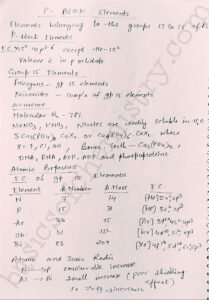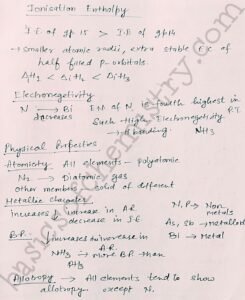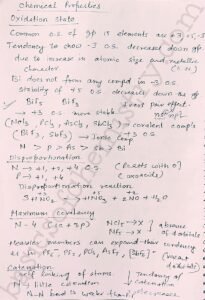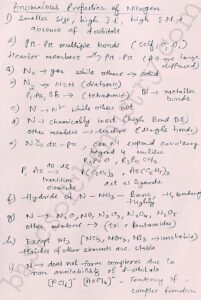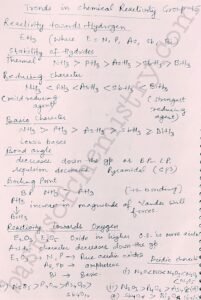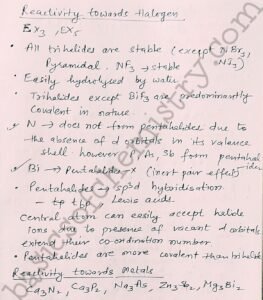Lesson 1
Group 15 elements p block elements properties
Notes on group 15 elements p block elements class 12 properties
Go through the video for the explanation of the notes on group 15 Elements p block elements ncert
P block elements group 15 elements
Group 15 elements are also called pnicogens which means suffocation as group 15 elements form suffocating gases.
Occurrence
Molecular nitrogen comprises about 78% by volume of Earth’s atmosphere molecular nitrogen occurs has potassium nitrate, sodium nitrate in the earth crust it is also present as an important constituent in proteins amino acids and nucleic acids.
Phosphorus is the essential constituent of of animal and plant materials bones and teeth and also in various biomolecules like DNA, RNA, ATP and so on.
Atomic properties
Electronic configuration of group 15 elements p block elements
The valence shell electronic configuration of group 15 elements is ns2 np3. Group 15 elements are having half filled P orbitals which makes them extra stable.
Atomic and ionic radii of group 15 elements p block elements
On moving down the group the atomic number of the element increases and therefore the atomic and ionic radii of the elements increases because of the addition of new shell everytime as we go down the group.
There is a remarkable increase in the covalent radius from nitrogen to phosphorus however from arsenic to Bismuth there is a small increase in covalent radius because of the presence of completely filled d or f orbitals.
As d and f orbitals causes poor shielding of the valence electron of these group 15 elements therefore the effective nuclear charge increases which in turn reduces the effect of incoming new energy shell.
Ionization enthalpy of group 15 elements p block elements
Ionization enthalpy of group 15 elements is lower than that of group 14 elements in their respective period because of smaller atomic radii and extra stable half filled P orbitals of group 15 elements.
Electronegativity of group 15 elements p block elements
Generally electronegativity decreases down the group because of the increase in atomic size however nitrogen is the fourth highest electronegative element in the periodic table.
Chemical properties of group 15 elements
Oxidation State of group 15 elements p block elements
Group 15 elements shows the common oxidation state of – 3 + 3 and + 5. The tendency to show -3 oxidation State decreases down the group due to increase in atomic radii.
But this Bi does not form any compound in -3 oxidation state. As we go down the group the stability of lower oxidation State becomes more stable due to inert pair effect therefore the stability of plus 3 oxidation State increases down the group.
The covalent character of the compounds of group 15 elements also decreases down the group.
Disproportionation reaction group 15 elements p block elements
The redox reactions in which the same element undergoes oxidation and reduction are called as disproportionation reaction. HNO2 undergoes disproportionation reaction in acidic medium nitrogen shows + 1 + 2 and + 4 oxidation States when it reacts with oxygen while Phosphorus shows + 1 and + 4 oxidation states in some oxoacids.
Covalency of group 15 elements
The maximum covalency shown by nitrogen is 4 because of the lack of d orbitals in its valence shell it cannot expand its covalency beyond four.
Heavier members group 15 elements like Phosphorus because of the presence of d orbitals can expand their covalency in most of their compounds.
Property of catenation
Self linking property of atom is called as catenation. Elements of group 15 showing catenation property decreases on moving down the group due to decrease in bond enthalpy. However nitrogen has very little tendency for catenation due to internal electronic repulsions in nitrogen molecule.
For more updates join me on 👇
Website – https://basicsofchemistry.com/
Instagram – https://www.instagram.com/monabindalgupta/
Facebook – https://www.facebook.com/monabindalgupta/
Twitter – https://twitter.com/monabindalgupta
Quora – https://www.quora.com/profile/Mona-Gupta-202
LinkedIn – https://www.linkedin.com/in/mona-gupta-7b450519a

